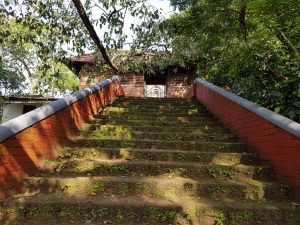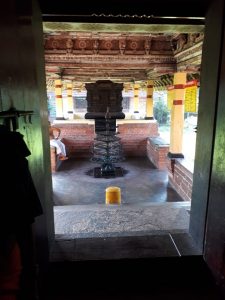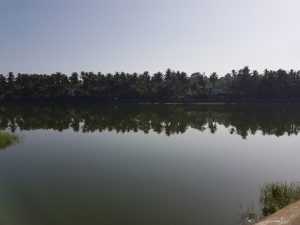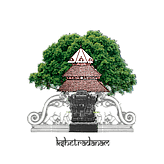Sree Thrikkaikunnu Mahadeva Temple, Kottayam
Sree Thrikkaikunnu Mahadeva Temple, Kottayam






Datable to eleventh century, the temple is associated with Kottayam Raajas who were great devotees and had special rights at the Kottiyoor temple. The ritual of giving prasaadam to the Kottayam Raaja by the priest of Kottiyoor temple was in a special manner. The rule was that the Raaja after taking prasaadam given to him in a silver bowl should place the bowl back at the same place. Once a child of the Royal family took the bowl from the Raaja and refused to give it back to the priest. As the Royal family was responsible for the maintenance of the temple, the priest did not insist on getting the bowl back that bowl and allowed the child to take it away. When the Raaja insisted that the child should give the bowl back, the child refused. As the bowl belonged to the temple, it caused worry to the Raaja and he held a prashnam after reaching his palace. The prashnam revealed the importance of Kottiyoor as a great sacrificial place and it also made clear that none should take away any article belonging to that place. Further it revealed the fact that it was the place where Goddess Sathi disappeared in the altar after relinquishing all worldly attachments. It was observed in the prashna that the child should have returned the bowl. As an atonement it was prescribed in the prashna that the members of the Royal family should desist from visiting Kottiyoor temple thereafter. In the next year when the festival of Kottiyoor started, the Raaja forgetting this direction. proceeded to Kottiyoor with his accompaniments. On his way, he saw a serpent obstructing his way. His guard killed that serpent with his sword. Thereafter serpents came one after another in a row and they killed the guard. A many-hooded serpent appeared before the Raaja all on a sudden. The Raaja with great fear sat on the ground and prayed to the Lord for pardoning him for his misdeeds, if any. Then he heard an incorporeal that as he had disobeyed the directions revealed in the prashnam, he should not visit Kottiyoor. A prashnam which followed revealed that the Lord was greatly pleased with his faith in the Lord and had decided to make his presence felt at the nearby Sree Mahadeva temple, the tutelar deity of his family. The Raaja visited the temple and to his great astonishment saw hands of the Lord on the top of an arayaal /Baniyan plant. The Raaja arranged to put soil upto the top of the plant where he saw the hands of the Lord (Thrikkai) which formed a mound (locally called kunnu). Thereafter the temple is known as Thrikkaikunnu.
It is believed that the properties of the temple originally belonged to Nampoothiri families. However. subsequently they came into the hands of Kottayam Royal family. At present the temple is owned by the Bhajana kovilakam (of Kottayam Raajas). With his permission, the Kshethra Samrakshana Samithi,consisting of 15 members elected once in a year by devotees administers the temple. The day-to-day administration is done by the Secretary with the concurrence of the Raaja on important matters.
The details of the land prior to the Land Reforms Act are not available. At present, the temple owns 2.26 acres of temple complex and a chira (tank) having an area of 13 acres. The structures on the temple complex are two important sreekovils, sub-shrines, namaskaara-mandapams, chuttambalam, wells, chira and gopuram.
The square dwi-thala sreekovil of saandhaara type for Lord Mahadeva, with mukha-mandapam and facing east is built with laterite stone adhishthaanam and walls and tiled roof for the eka-thala-part and copper plate for the dwi-thala rool. The mouldings of the laterite adhishthaanam are paadukam, jagathi vrutha-kumudam, kumuda-padi, kampam galam, gala-padi, kampam, galam, gala-padi, valaru and padi. The sopaanam has eight direct steps. At the curved portions of banisters lotus-buds are carved while on sides the full figurine of Nandi. The granite pranaalam has vyaali-mukham at the base and multi-faceted sundu with pearl rings. The laterite walls have two ghana-dwaaras and have niches which contain motifs of faces ofishis and Devas. Carved wooden vyaali figurines holding the raised trunks of elephants by sitting on these elephant figurines are provided beneath the roof as if they support the roof. The bali peethas around the main sreekovil which represent ashta dikhpaalas and saptha-maathrikkal deserve special mention. Unlike the general pattern of single sila in this temple, these bali-peethas are built with mouldings of adhishthaanam having a total height of 45 cm.
The namaskaara-mandapam has sixteen wooden pillars, four inner ones in round shape and 12 outer with square shape. At the centre of the northern portion of the namaskaara mandapam, there is a sub-shrine for Goddess stated to be in the sankalpa of Goddess Parvathi,the Goddess who accompanied Sree Kottiyoor Perumaal and Sree Porkkali Bhagavathi. This idol is within a shrine having wooden bars as walls. But according to devaprasnam of 1993, the sankalpa of the idol is of Porkkali Bhagavathi. In the devaprasnam, It was also prescribed to build separate shrine at the north-west naalambalam for installing Sree Durga Parameshwari and Sree Parvathi.
On the northern side of the main sreekovil and within the akathe balivattom is the elevated sreekovil of the swayambhoo idol of Kottiyoor Perumaal. This sreekovil has also a separate small namaskara-mandapam. There is a well at the north-east of akathe balivattom.
The chuttambalam with a projected vaathilmaatam (used as kooththambalam) and an agramandapam has two entrances ,i.e at east and at north. The sub-shrine of Lord Ganapathi is at the south-west of naalambalam. There are two thidapilli one at south-east and the other at north east. The south-west thidapilli has a nadavazhi attached to the thidapilli but detached from the main namaskaara mandapam. There are three rooms at the chuttambalam close to the thidapilli. The tall laterite valiya-balikal within the agra-mandapam has all the mouldings besides niches. Around the chuttambalam, there is a pradakshina-vazhi (built of laterite stones).
The sub-shrine at south-east (outside the chuttambalam) of Lord Ayyappa, facing west, has an attached mandapam. To its south there is another well. The sub-shrine of Sree Krishna,facing east at north-west has also a mandapam in front of it. There are two gopuras-one at the east and the other at north. The eastern gopuram has rooms on sides while the other one has only one entrance.
The chira (tank) having an extent of 13 acres is an important land-mark. It is said that initially there was no water when it was dug. Then a great ascetic came and directed to feed 100 Brahmins. Their recital of gayathri-manthram and prayers before taking food and their happiness resulted in un-interrupted spring at the chira and soon it was filled up. The general belief is that the ascetic is none other than Sree Kottiyoor Perumaal.
The temple has exquisite carvings of Rishis, Devas etc. At the front of the sreekovil, there are wooden dwaarapaalas with club in hand and having a height of 165 cm. On the gala-part of dwi-thala there are wooden figurines of thri-moorthis (Lord Brahma, Maha Vishnu and Lord Siva). There are also wooden carvings on the ceiling of namaskaara-mandapam, vaathil maatam and agra-mandapam, depicting nava-grahas, figurines of Devas in fighting postures, deva-ganas, flowers besides depicting episodes of Kiraathan, Paalaazhi-madhanam, raasa-kreeda etc. The colouring of the wooden figurines has affected their aesthetic appearance. The mural paintings also deserve special mention.
The idol of the main sreekovil is of sila of linga-type with a height of 67 cm. The swayambhoo idol of sree (Kottiyoor) Perumaal within the inner courtyard is also of sila having a height of about 27 cm. The sila idol of Lord Ganapathi is in sitting posture and has a height of about 57 cm. The pancha-loha idol of Lord Ayyappa is peculiar and in the form of sitting on horse with sword in hand (the total height being about 105 cm.). The sila idol of Sree Gopalakṛshna is in standing pose.
At present the temple is kept open on all days from 5:30 to 10:30 AM and from 5:30 PM to 8:30PM.Two poojas are held daily ie. usha-pooja at 7:30 AM and athaazha pooja at 8 PM. After closing the temple at night, none dares to enter the maryaada of the temple. Some years back certain persons entered the compound at night for staying there. Then a large granite piece fell on them. This stone still can be seen lying there. Thereafter devotees avoid staying in temple complex after 8:30 PM.
The main vazhippadu are dhaara, pushpaanjali, karuka-homam and nira-maala. Of these dhaara is very popular.
The annual festival is held for seven days commencing from chothi nakshatram in the month of Kumbham. All temple rites are done here, besides staging Kathakali, thullal and modern entertainments.
The thanthris of the temple belong to Nandyaarvalli Thekkedath mana (Chalakudi) and Kozhikkottiri mana (Pattambi). The saanthikkaaran is appointed from Nampoothiris and it is a non-hereditary post. There is no other paid staff at present.
The temple is located at 15 km. north-east of Thalassery or two km. north west of Koothuparambu on Kannoor road or 200 m. east of Kottayam-Malabar post office. The temple is connected by tarred road. Facilities for stay are available at Koothuparambu.




